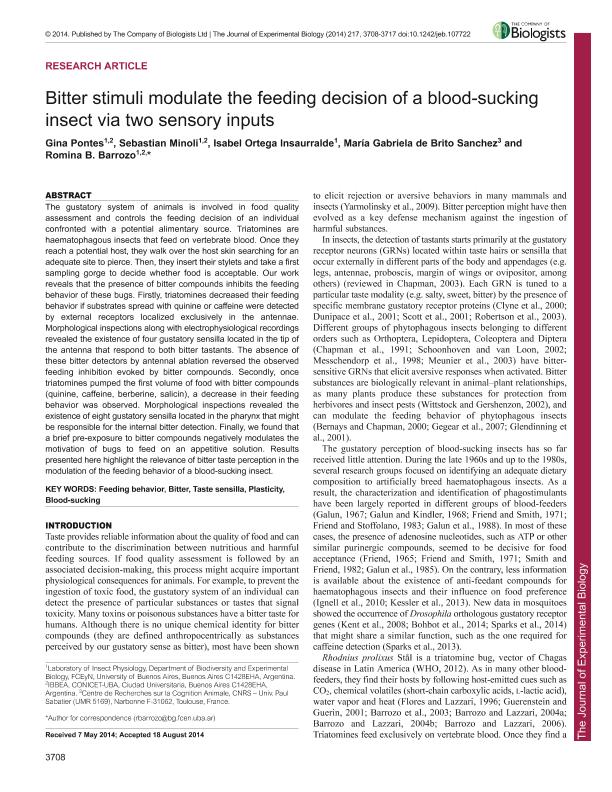Mostrar el registro sencillo del ítem
dc.contributor.author
Barcelos Pontes, Gina

dc.contributor.author
Minoli, Sebastian Antonio

dc.contributor.author
Ortega Insaurralde, Isabel

dc.contributor.author
De Brito Sanchez, Maria Gabriela
dc.contributor.author
Barrozo, Romina

dc.date.available
2018-01-02T21:59:18Z
dc.date.issued
2014-08
dc.identifier.citation
Barrozo, Romina; De Brito Sanchez, Maria Gabriela; Ortega Insaurralde, Isabel; Minoli, Sebastian Antonio; Barcelos Pontes, Gina; Bitter stimuli modulate the feeding decision of a blood-sucking insect via two sensory inputs; Company of Biologists; Journal of Experimental Biology; 217; 8-2014; 3708-3717
dc.identifier.issn
0022-0949
dc.identifier.uri
http://hdl.handle.net/11336/32083
dc.description.abstract
The gustatory system of animals is involved in food quality assessment and controls the feeding decision of an individual confronted with a potential alimentary source. Triatomines are haematophagous insects that feed on vertebrate blood. Once they reach a potential host, they walk over the host skin searching for an adequate site to pierce. Then, they insert their stylets and take a first sampling gorge to decide whether food is acceptable. Our work reveals that the presence of bitter compounds inhibits the feeding behavior of these bugs. Firstly, triatomines decreased their feeding behavior if substrates spread with quinine or caffeine were detected by external receptors localized exclusively in the antennae. Morphological inspections along with electrophysiological recordings revealed the existence of four gustatory sensilla located in the tip of the antenna that respond to both bitter tastants. The absence of these bitter detectors by antennal ablation reversed the observed feeding inhibition evoked by bitter compounds. Secondly, once triatomines pumped the first volume of food with bitter compounds (quinine, caffeine, berberine, salicin), a decrease in their feeding behavior was observed. Morphological inspections revealed the existence of eight gustatory sensilla located in the pharynx that might be responsible for the internal bitter detection. Finally, we found that a brief pre-exposure to bitter compounds negatively modulates the motivation of bugs to feed on an appetitive solution. Results presented here highlight the relevance of bitter taste perception in the modulation of the feeding behavior of a blood-sucking insect.
dc.format
application/pdf
dc.language.iso
eng
dc.publisher
Company of Biologists

dc.rights
info:eu-repo/semantics/openAccess
dc.rights.uri
https://creativecommons.org/licenses/by-nc-sa/2.5/ar/
dc.subject
Feeding Behaviour
dc.subject
Bitter
dc.subject
Taste Sensilla
dc.subject
Plasticity
dc.subject.classification
Otras Ciencias Biológicas

dc.subject.classification
Ciencias Biológicas

dc.subject.classification
CIENCIAS NATURALES Y EXACTAS

dc.title
Bitter stimuli modulate the feeding decision of a blood-sucking insect via two sensory inputs
dc.type
info:eu-repo/semantics/article
dc.type
info:ar-repo/semantics/artículo
dc.type
info:eu-repo/semantics/publishedVersion
dc.date.updated
2017-12-29T14:20:16Z
dc.journal.volume
217
dc.journal.pagination
3708-3717
dc.journal.pais
Reino Unido

dc.journal.ciudad
Cambridge
dc.description.fil
Fil: Barcelos Pontes, Gina. Consejo Nacional de Investigaciones Científicas y Técnicas. Oficina de Coordinación Administrativa Ciudad Universitaria. Instituto de Biodiversidad y Biología Experimental y Aplicada. Universidad de Buenos Aires. Facultad de Ciencias Exactas y Naturales. Instituto de Biodiversidad y Biología Experimental y Aplicada; Argentina
dc.description.fil
Fil: Minoli, Sebastian Antonio. Consejo Nacional de Investigaciones Científicas y Técnicas. Oficina de Coordinación Administrativa Ciudad Universitaria. Instituto de Biodiversidad y Biología Experimental y Aplicada. Universidad de Buenos Aires. Facultad de Ciencias Exactas y Naturales. Instituto de Biodiversidad y Biología Experimental y Aplicada; Argentina
dc.description.fil
Fil: Ortega Insaurralde, Isabel. Universidad de Buenos Aires. Facultad de Ciencias Exactas y Naturales. Departamento de Biodiversidad y Biología Experimental; Argentina. Consejo Nacional de Investigaciones Científicas y Técnicas; Argentina
dc.description.fil
Fil: De Brito Sanchez, Maria Gabriela. Université Paul Sabatier; Francia
dc.description.fil
Fil: Barrozo, Romina. Consejo Nacional de Investigaciones Científicas y Técnicas. Oficina de Coordinación Administrativa Ciudad Universitaria. Instituto de Biodiversidad y Biología Experimental y Aplicada. Universidad de Buenos Aires. Facultad de Ciencias Exactas y Naturales. Instituto de Biodiversidad y Biología Experimental y Aplicada; Argentina
dc.journal.title
Journal of Experimental Biology

dc.relation.alternativeid
info:eu-repo/semantics/altIdentifier/doi/http://dx.doi.org/10.1242/jeb.107722
dc.relation.alternativeid
info:eu-repo/semantics/altIdentifier/url/http://jeb.biologists.org/content/217/20/3708
Archivos asociados
